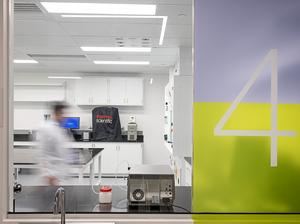It’s ironic, really.
By definition, an advertising agency exists to boost the visibility and awareness of a brand. Inphantry, a digital ad agency based in Boston, has been doing just that for some of the most well-known companies in the world over the past five years—but has itself managed to fly under the radar.
You may have never heard of Inphantry, but no doubt you’re familiar with Puma, Guinness, Johnny Walker, Jose Cuervo, Verizon, Nintendo, VH1 and Beats—just a handful of companies the local agency has led projects for. Its first client? Bombay Sapphire, for which the then four-person team developed a multi-part virtual lesson for mixologists that included an educational video and interactive tasting kit breaking down the spirit’s individual botanicals and complex flavor notes.
Inphantry’s work speaks for itself. Which is probably why the majority of their projects have rolled in via word of mouth. In fact, an estimated 70 percent of their work comes from referrals, and the remaining 30 percent comes directly from existing clients.
Inphantry aims to set itself apart through a die-hard dedication to customizing every campaign it creates. The firm's work can be tough to sum up because every project is vastly different—depending on the brand, the product they’re focused on promoting, their customers and the technologies that are most suited to getting the message across.
From mobile apps to social photo booths and augmented reality, Inphantry is all about enabling consumers to experience a brand in more tangible ways.
The one element that's consistent across Inphantry’s portfolio, however, is its fixation on experiential marketing. From mobile apps to social photo booths and augmented reality, Inphantry is all about enabling consumers to encounter and interact with a brand in more tangible ways. At its core, that’s what experiential marketing is: messaging you can not only see, but touch, hear and feel in a physical space. The premise is to strengthen the bond between a brand and the consumer, and it’s effective because it's not only memorable, but it gets people participating. In recent years, the rise of technologies like social media have kicked this approach into high gear.
A diverse portfolio
A 2013 Nike campaign illustrates this strategy perfectly. During the NBA All-Star Game in Houston, the footwear company debuted the AJXX8—a highly hyped shoe and the 28th in the iconic Air Jordan line. Inphantry helped the company to put on a large-scale special attraction in a Texas shopping mall, at which all visitors donned personalized Jordan bracelets containing an RFID chip.
When those bracelets were scanned, attendees were granted entrance to a series of challenges, from dribbling to slam dunk, which they needed to complete before accessing a pop-up museum exhibition chronicling the sneaker’s history. There, they could try on the AJXX8 ahead of its public release, as well as purchase the shoe from an exclusive retailer conveniently located right in the mall. The highest performers not only saw their names up on the leaderboard, but also gained entrance to a VIP lounge with pro basketball players and other celebrities. Meanwhile, sneakerheads were encouraged to Tweet and Instagram their thoughts and photos for real-time wall recognition on screens within the activation space. The event was, undoubtedly, a success: Inphantry co-founder and creative director Kevin Lee estimates that 85 percent of visitors bought a pair of the new Jordans.
Inphantry’s biggest hit in a social respect, though, was designed for HISTORY’s “Vikings” series at Comic-Con 2014 in San Diego. Once on the “set,” which was outside the convention center, attendees registered on an iPad to create their very own Vikings character profiles. Each person was then given a printout containing a unique code, which slid into their Comic-Con lanyard passes. When the pass was scanned, images and videos from each station within the activation were instantly uploaded to each fan’s page.
At one station, fans received a Vikings-style professional makeover including hair braiding, tattoos, blood smears—the works. At another station, they snapped shots against a green screen display from the series in wardrobe and with various props, leaving with a high-quality new-season “promo” poster of their photos. Visitors could also star in a 30-second promo video against a ship or temple backdrop. At the final station, they scanned their cards to see their finished cast pages with their profiles, character concept sketches, photos and videos from all the experiences, which they could share on social networks. Lee says fans waited four up to six hours for this experience.
Always looking ahead
Business development and brand strategy manager Cameron King, who just joined the team this past winter, sums up Inphantry’s tactics in one simple phrase: “We’re forward-thinking.”
Sure, that means continually staying on top of new technologies, but at the end of the day, Inphantry isn’t about jumping on the bandwagon with every new digital trend. Clients don’t come to the agency demanding a campaign using a specific technology—it’s just not how Inphantry operates. They need to trust the agency—specifically, co-founder and Technical Producer Derek Tran—to decide which strategies will engage consumers most effectively. That said, they seek to maintain a constant awareness about products coming down the pipeline. Right now, Lee says they’re particularly pumped about Myo, an armband that works as a wearable presentation remote. Using motion and muscle sensors, Myo can track your movements and gestures and read them as input commands.
There are six full-time employees at Inphantry right now, and despite the wealth of work that pours in at certain times, the company only plans to bring on two or three more people—if that. Truthfully, Lee—a Massachusetts native who previously worked as an art director for Digitas and senior interactive designer for John Hancock—says he feels they’ve reached the magic number for optimal collaboration.
So what’s the top priority? While they may have worked with some of the most well-known brands in the world, Inphantry is especially eager to get involved with those right here in The Hub—whether big or small. Fiksu is one example of a Boston area company that leveraged Inphantry’s services. For the 2013 Mobile World Congress in Barcelona, the company wanted a compelling way to give attendees insight into a new product without relying on a PowerPoint. Inphantry streamlined the demo into a motion graphics narrative experience that people could enter or leave at any time, walking away with key info while still having a reason to learn more. To this day, Fiksu still uses this video as part of its sales initiative.
“We’d love to work with more Boston startups,” says King. “Ideally, we want to be their go-to."
All photos courtesy of Inphantry.








